We’ve just returned from a jam-packed PCMA Convening Leaders program, and presentations by three very different keynoters — each inspiring in their own way — are still playing in my head. Opening General Session speaker Neri Oxman, architect, designer, inventor, and MIT Media Lab associate professor, spoke about “the future of making,” and how we are transcending boundaries with biomaterials. It captured the audience’s imagination, even if some tweeted that it was hard for them to know how to apply what she presented to their work.
General Stanley McChrystal commanded our attention, but not as I might have expected, sharing his humble approach to leadership. Whether it’s the kind of leader we’d like to have or the leader we aspire to become, we could all relate to his message about the difference between leading and managing people. Last to speak was Bill Strickland, who transfixed the audience with a plainspoken talk about how the lives of kids in Pittsburgh’s poor neighborhoods have been transformed through art and human decency. His humanitarian work resonated with the audience, although event designers likely found his belief in the beneficial effect of beautiful environments on people’s psyches most relevant. (Read our interview with Strickland at convn.org/strickland-pcma.)
At the same time that Convening Leaders was kicking off, Oprah Winfrey was also making a speech, accepting the Cecil B. DeMille Award for Lifetime Achievement at the Golden Globes. Her remarks were an immediate sensation, and within hours, Oprah’s speech came to be seen as the gold standard in engaging audiences, the main goal of all events. Looking at what made it work helps me see where and why Convening Leaders keynoters succeeded and reminded me, once again, that storytelling is at the heart of how humans communicate with one another.
On LinkedIn, presentation coach Sam Horn analyzed the elements in her speech that stole the show (convn.org/horn-oprah, condensed and paraphrased below):
1. She showed up to serve — not to impress — the audience.
2. She started with a story — how as a child she was sitting on a linoleum floor watching TV when Sidney Poitier became the first black man to win an Oscar — and didn’t skimp on the details in order to paint a picture in our minds.
3. She spoke naturally, without notes or a teleprompter.
4. Even though her speech lasted nine minutes, every word mattered.
5. She was straightforward — no embellishing or grandstanding.
6. It had a reveal (a surprising and little-known historical fact).
7. She included repeatable, retweetable sound-bites.
8. She created an emotional crescendo at the end in a natural, not manufactured way.
Kindra Hall, public speaking expert, author — and Convening Leaders 2018 speaker herself — also assessed what made Oprah’s speech “rock” in an Inc. article (convn.org/kindra-oprah). Similar to Horn, Hall focused on Oprah’s expert storytelling techniques, and pointed out how her conclusion brought us full circle. “Ending the presentation with a nod to the opening story is an expert speaking move,” she wrote, “that creates an immense sense of satisfaction and delight for the listeners.” It’s all about serving the audience.

